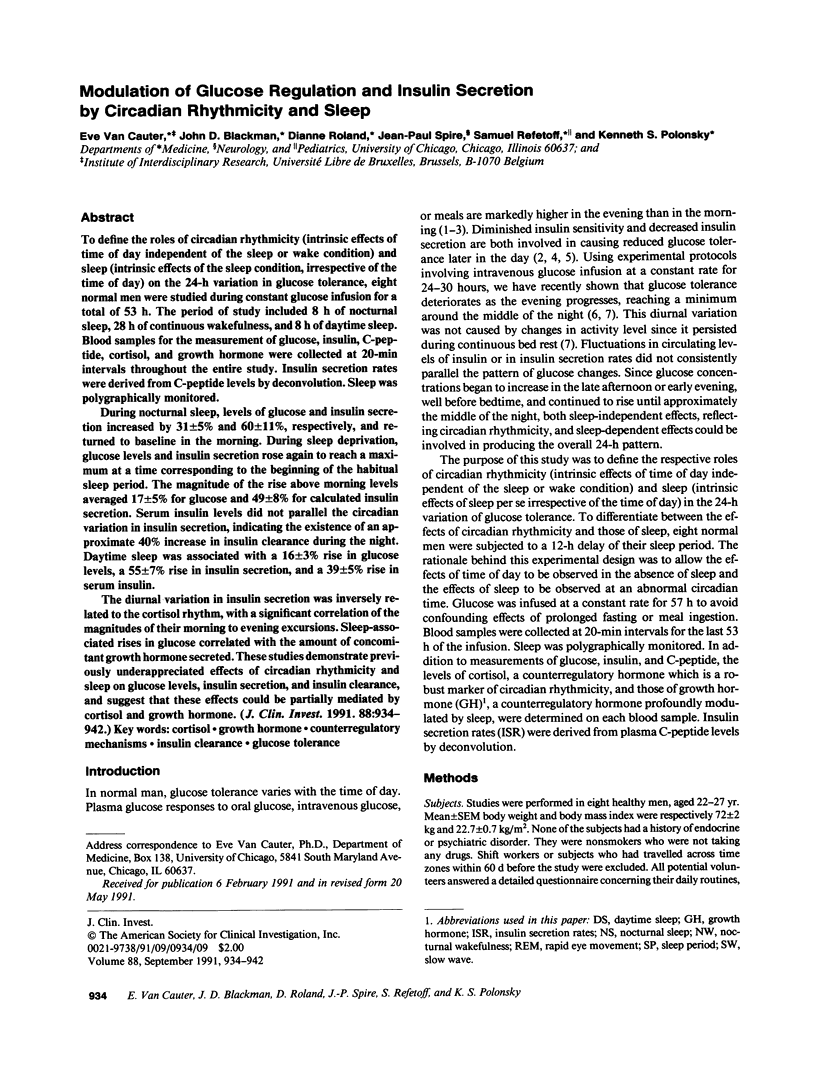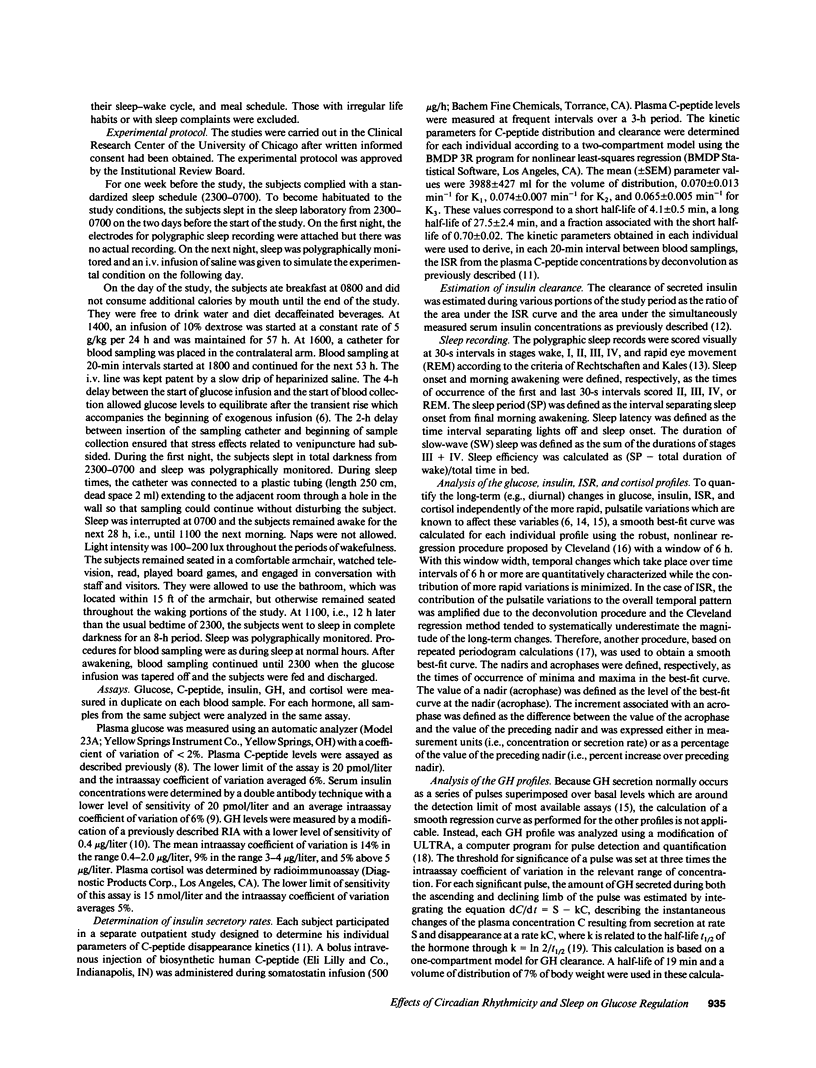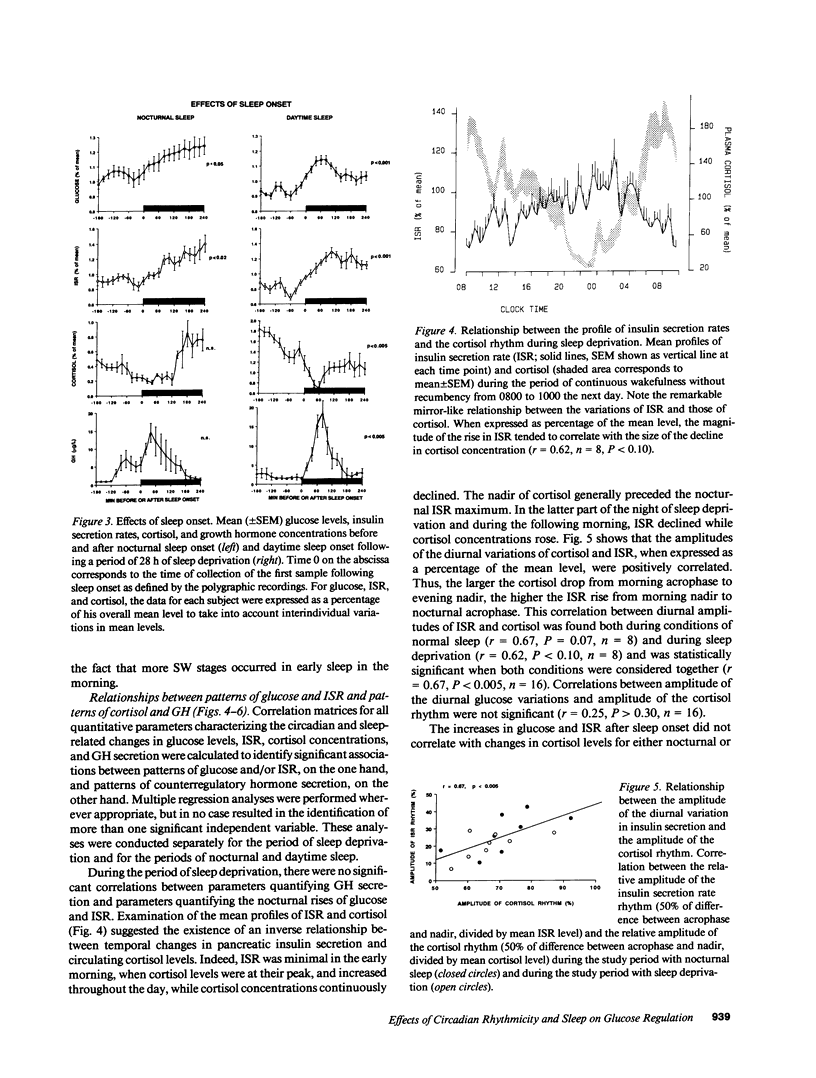Abstract
To define the roles of circadian rhythmicity (intrinsic effects of time of day independent of the sleep or wake condition) and sleep (intrinsic effects of the sleep condition, irrespective of the time of day) on the 24-h variation in glucose tolerance, eight normal men were studied during constant glucose infusion for a total of 53 h. The period of study included 8 h of nocturnal sleep, 28 h of continuous wakefulness, and 8 h of daytime sleep. Blood samples for the measurement of glucose, insulin, C-peptide, cortisol, and growth hormone were collected at 20-min intervals throughout the entire study. Insulin secretion rates were derived from C-peptide levels by deconvolution. Sleep was polygraphically monitored. During nocturnal sleep, levels of glucose and insulin secretion increased by 31 +/- 5% and 60 +/- 11%, respectively, and returned to baseline in the morning. During sleep deprivation, glucose levels and insulin secretion rose again to reach a maximum at a time corresponding to the beginning of the habitual sleep period. The magnitude of the rise above morning levels averaged 17 +/- 5% for glucose and 49 +/- 8% for calculated insulin secretion. Serum insulin levels did not parallel the circadian variation in insulin secretion, indicating the existence of an approximate 40% increase in insulin clearance during the night. Daytime sleep was associated with a 16 +/- 3% rise in glucose levels, a 55 +/- 7% rise in insulin secretion, and a 39 +/- 5% rise in serum insulin. The diurnal variation in insulin secretion was inversely related to the cortisol rhythm, with a significant correlation of the magnitudes of their morning to evening excursions. Sleep-associated rises in glucose correlated with the amount of concomitant growth hormone secreted. These studies demonstrate previously underappreciated effects of circadian rhythmicity and sleep on glucose levels, insulin secretion, and insulin clearance, and suggest that these effects could be partially mediated by cortisol and growth hormone.
Full text
PDF








Images in this article
Selected References
These references are in PubMed. This may not be the complete list of references from this article.
- Carroll K. F., Nestel P. J. Diurnal variation in glucose tolerance and in insulin secretion in man. Diabetes. 1973 May;22(5):333–348. doi: 10.2337/diab.22.5.333. [DOI] [PubMed] [Google Scholar]
- Clore J. N., Nestler J. E., Blackard W. G. Sleep-associated fall in glucose disposal and hepatic glucose output in normal humans. Putative signaling mechanism linking peripheral and hepatic events. Diabetes. 1989 Mar;38(3):285–290. doi: 10.2337/diab.38.3.285. [DOI] [PubMed] [Google Scholar]
- Faber O. K., Binder C., Markussen J., Heding L. G., Naithani V. K., Kuzuya H., Blix P., Horwitz D. L., Rubenstein A. H. Characterization of seven C-peptide antisera. Diabetes. 1978;27 (Suppl 1):170–177. doi: 10.2337/diab.27.1.s170. [DOI] [PubMed] [Google Scholar]
- Golstein J., Van Cauter E., Désir D., Noël P., Spire J. P., Refetoff S., Copinschi G. Effects of "jet lag" on hormonal patterns. IV. Time shifts increase growth hormone release. J Clin Endocrinol Metab. 1983 Mar;56(3):433–440. doi: 10.1210/jcem-56-3-433. [DOI] [PubMed] [Google Scholar]
- Ho K. Y., Veldhuis J. D., Johnson M. L., Furlanetto R., Evans W. S., Alberti K. G., Thorner M. O. Fasting enhances growth hormone secretion and amplifies the complex rhythms of growth hormone secretion in man. J Clin Invest. 1988 Apr;81(4):968–975. doi: 10.1172/JCI113450. [DOI] [PMC free article] [PubMed] [Google Scholar]
- Linsell C. R., Lightman S. L., Mullen P. E., Brown M. J., Causon R. C. Circadian rhythms of epinephrine and norepinephrine in man. J Clin Endocrinol Metab. 1985 Jun;60(6):1210–1215. doi: 10.1210/jcem-60-6-1210. [DOI] [PubMed] [Google Scholar]
- Møller N., Butler P. C., Antsiferov M. A., Alberti K. G. Effects of growth hormone on insulin sensitivity and forearm metabolism in normal man. Diabetologia. 1989 Feb;32(2):105–110. doi: 10.1007/BF00505182. [DOI] [PubMed] [Google Scholar]
- Orskov L., Schmitz O., Jørgensen J. O., Arnfred J., Abildgaard N., Christiansen J. S., Alberti K. G., Orskov H. Influence of growth hormone on glucose-induced glucose uptake in normal men as assessed by the hyperglycemic clamp technique. J Clin Endocrinol Metab. 1989 Feb;68(2):276–282. doi: 10.1210/jcem-68-2-276. [DOI] [PubMed] [Google Scholar]
- Polonsky K. S., Given B. D., Van Cauter E. Twenty-four-hour profiles and pulsatile patterns of insulin secretion in normal and obese subjects. J Clin Invest. 1988 Feb;81(2):442–448. doi: 10.1172/JCI113339. [DOI] [PMC free article] [PubMed] [Google Scholar]
- Polonsky K. S., Licinio-Paixao J., Given B. D., Pugh W., Rue P., Galloway J., Karrison T., Frank B. Use of biosynthetic human C-peptide in the measurement of insulin secretion rates in normal volunteers and type I diabetic patients. J Clin Invest. 1986 Jan;77(1):98–105. doi: 10.1172/JCI112308. [DOI] [PMC free article] [PubMed] [Google Scholar]
- Reaven G. M., Hollenbeck C., Jeng C. Y., Wu M. S., Chen Y. D. Measurement of plasma glucose, free fatty acid, lactate, and insulin for 24 h in patients with NIDDM. Diabetes. 1988 Aug;37(8):1020–1024. doi: 10.2337/diab.37.8.1020. [DOI] [PubMed] [Google Scholar]
- Refetoff S., Sönksen P. H. Disappearance rate of endogenous and exogenous human growth hormone in man. J Clin Endocrinol Metab. 1970 Mar;30(3):386–392. doi: 10.1210/jcem-30-3-386. [DOI] [PubMed] [Google Scholar]
- Service F. J., Hall L. D., Westland R. E., O'Brien P. C., Go V. L., Haymond M. W., Rizza R. A. Effects of size, time of day and sequence of meal ingestion on carbohydrate tolerance in normal subjects. Diabetologia. 1983 Oct;25(4):316–321. doi: 10.1007/BF00253193. [DOI] [PubMed] [Google Scholar]
- Shapiro E. T., Tillil H., Miller M. A., Frank B. H., Galloway J. A., Rubenstein A. H., Polonsky K. S. Insulin secretion and clearance. Comparison after oral and intravenous glucose. Diabetes. 1987 Dec;36(12):1365–1371. doi: 10.2337/diab.36.12.1365. [DOI] [PubMed] [Google Scholar]
- Shapiro E. T., Tillil H., Polonsky K. S., Fang V. S., Rubenstein A. H., Van Cauter E. Oscillations in insulin secretion during constant glucose infusion in normal man: relationship to changes in plasma glucose. J Clin Endocrinol Metab. 1988 Aug;67(2):307–314. doi: 10.1210/jcem-67-2-307. [DOI] [PubMed] [Google Scholar]
- Simon C., Brandenberger G., Follenius M. Ultradian oscillations of plasma glucose, insulin, and C-peptide in man during continuous enteral nutrition. J Clin Endocrinol Metab. 1987 Apr;64(4):669–674. doi: 10.1210/jcem-64-4-669. [DOI] [PubMed] [Google Scholar]
- Turek F. W. Circadian neural rhythms in mammals. Annu Rev Physiol. 1985;47:49–64. doi: 10.1146/annurev.ph.47.030185.000405. [DOI] [PubMed] [Google Scholar]
- Vaitkus P., Sirek A., Norwich K. H., Sirek O. V., Unger R. H., Harris V. Rapid changes in hepatic glucose output after a pulse of growth hormone in dogs. Am J Physiol. 1984 Jan;246(1 Pt 1):E14–E20. doi: 10.1152/ajpendo.1984.246.1.E14. [DOI] [PubMed] [Google Scholar]
- Van Cauter E., Désir D., Decoster C., Féry F., Balasse E. O. Nocturnal decrease in glucose tolerance during constant glucose infusion. J Clin Endocrinol Metab. 1989 Sep;69(3):604–611. doi: 10.1210/jcem-69-3-604. [DOI] [PubMed] [Google Scholar]
- Van Cauter E. Estimating false-positive and false-negative errors in analyses of hormonal pulsatility. Am J Physiol. 1988 Jun;254(6 Pt 1):E786–E794. doi: 10.1152/ajpendo.1988.254.6.E786. [DOI] [PubMed] [Google Scholar]
- Van Cauter E. Method for characterization of 24-h temporal variation of blood components. Am J Physiol. 1979 Sep;237(3):E255–E264. doi: 10.1152/ajpendo.1979.237.3.E255. [DOI] [PubMed] [Google Scholar]
- Vance M. L., Thorner M. O. Fasting alters pulsatile and rhythmic cortisol release in normal man. J Clin Endocrinol Metab. 1989 Jun;68(6):1013–1018. doi: 10.1210/jcem-68-6-1013. [DOI] [PubMed] [Google Scholar]
- Verrillo A., De Teresa A., Martino C., Di Chiara G., Pinto M., Verrillo L., Torello F., Gattoni A. Differential roles of splanchnic and peripheral tissues in determining diurnal fluctuation of glucose tolerance. Am J Physiol. 1989 Oct;257(4 Pt 1):E459–E465. doi: 10.1152/ajpendo.1989.257.4.E459. [DOI] [PubMed] [Google Scholar]
- Virasoro E., Copinschi G., Bruno O. D., Leclerq R. Radioimmunoassay of human growth hormone using a charcoal-dextran separation procedure. Clin Chim Acta. 1971 Jan;31(1):294–297. doi: 10.1016/0009-8981(71)90392-5. [DOI] [PubMed] [Google Scholar]
- Weitzman E. D., Zimmerman J. C., Czeisler C. A., Ronda J. Cortisol secretion is inhibited during sleep in normal man. J Clin Endocrinol Metab. 1983 Feb;56(2):352–358. doi: 10.1210/jcem-56-2-352. [DOI] [PubMed] [Google Scholar]



